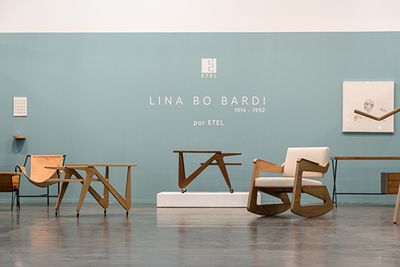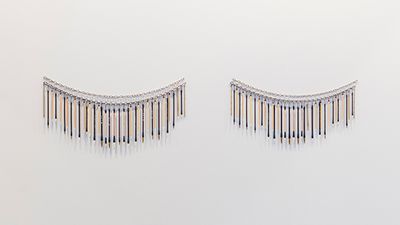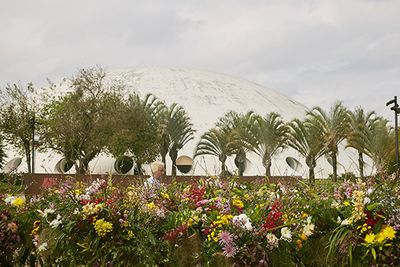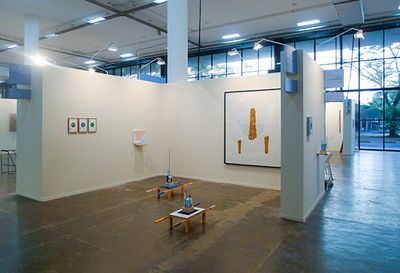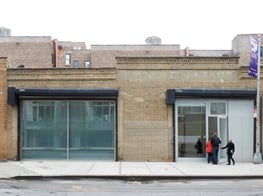Fair and Festival: SP-Arte 2017

Makoto Azuma's Flower Messenger performance. Organised by Japan House and inaugurated during SP-Arte 2017, São Paulo (6–9 April 2017). Courtesy Japan House, São Paulo.
This year, São Paulo's 13th SP-Arte (6–9 April 2017) balanced a strong sense of identity and place with a global perspective—achieved through the attendance of high-level international galleries coupled with an abundant offering of Brazilian and Latin American art. But this balance among more than 120 participating galleries went beyond the global and the regional. Housed in the striking modernist Oscar Niemeyer-designed Bienal Pavilion, which has hosted the event since its 2005 launch, the thirteenth edition of SP-Arte rebranded itself as an 'international art festival'. This semantic shift suggests an effort to curb the commercial connotations associated with the art fair format and appeal to potential visitors from outside the art world, given the delicate local economic climate.
SP-Arte's new identity acted as a conceptual embrace of the independent satellite events that were held across the city during the same period. An initiative named Gallery Nights that began last year kicked off the art week with two vibrant evenings on 3 and 4 April, during which galleries opened later than usual for guided visits, talks and receptions. Galeria Nara Roesler organised a talk between curator Brett Littman and the two Daniels—Buren and Senise—being exhibited in the gallery. Both artists were also represented at Roesler's booth at SP-Arte. Lining the exterior wall was Buren's three-and-a-half-metre-wide wall piece depicting geometric shapes created from wood, lacquer, vinyl adhesive and glue: Prismas e Espelhos, alto relevos, trabalhos situados 2016-2017 para São Paulo [Prisms and mirrors, high reliefs, situated works 2016-2017 for São Paulo] (2016). On another outward-facing wall was Senise's Sunrise (2017): an earthy-toned and predominantly geometric painting made by imprinting floor patterns onto the canvas.
For anyone keeping tabs, the relation between artworks on show at local galleries and their booths at SP-Arte was a recurring strategy. Ana Elisa Egreja's hyper-realistic oil paintings of scenes staged and photographed in her studio—from a flooded living room filled with tropical plants in Poça II [Puddle II] (2017), to a pink bathroom draped with octopuses and shells flanked by candles in Banheiro rosa com polvos [Pink Bathroom with Octopuses] (2017)—were on view at her solo exhibition Jacarezinho 92 (named after the artist's studio address) at Galeria Leme. At Leme's SP-Arte booth, Egreja presented the medium-sized painting Cozinha [Kitchen] (2016), which shows a section of a bright yellow 1950s kitchen. Veteran Brazilian gallerist Luciana Brito, who has in the past has often opted for a single-artist booth at art fairs, showed an array of different artists' artworks this year at SP-Arte, including three small canvases splashed with thick red pigment by Mexican artist Bosco Sodi, Untitled (2016). These reference the art exhibited in Sodi's solo show Voragine at the striking modernist house that is the gallery's venue.
Along with its 'international art festival' tagline, SP-Arte also debuted a new sector this year: 'Repertório' (translated as 'Repertoire'), curated by São Paulo-based curator Jacopo Crivelli Visconti. Located at the back of the second floor of the pavilion, which last year constituted a pleasant booth-less area for specially commissioned installations also curated by Crivelli Visconti, Repertório presented artworks made by artists born before the 1940s and whose work can be understood as 'fundamental in understanding contemporary art practices'. The sector, presented as a series of gallery booths, was conceived as an opportunity for local audiences to enhance their understanding of the cross-cultural relations that can be drawn between artworks made across the globe at different times.
Repertório included iconic examples of arte povera such as Senza Titolo 92 [Untitled 92] (1976–2013) by Michelangelo Pistoletto, presented by Galleria Continua, an emblematic piece that comprises opposing piles of white and coloured clothes separated by a vertical mirror. It also showed conceptual, minimalist, land art such as Richard Long's Merrivale Circle (1994), presented by Lisson Gallery: a representative example of his circular floor sculptures made from rocks. Also on display, courtesy of Alexander Gray Associates, was Luis Camnitzer's conceptual work The Shift of the Center of the Earth (1975). These and other seminal artworks were set in dialogue with art from Brazil, such as paintings by Carlos Vergara, Mario Cravo Neto's mystical black and white photographs of objects and people, and Lydia Okumura's Project for a Corner Piece XI (1975), which is made from several strings hung across a black painted corner. However, the experience could have been more enriching to visitors, and possible dialogues between works made stronger, had the selection been displayed more fluidly in the same area, rather than in booth format.
The 'Design' sector, introduced at SP-Arte last year, returned in 2017 with high-level examples of Brazilian modern and contemporary pieces authored by some of the country's most emblematic designers. ETEL, a specialist retailer focusing on refined contemporary wood furniture and re-edited vintage pieces, partnered with two artists for its splendid booth display. Artworks created by Walmor Corrêa, inspired by architect Lina Bo Bardi and exhibited recently at SESC Pompéia (a leisure and exhibition centre designed by Bo Bardi, who also designed São Paulo's Museum of Art, MASP), hung by a selection of impeccably re-edited furniture designs by Bo Bardi in the late 1940s. Designer Etel Carmona and artist Carlos Vergara (whose work was also shown at Repertório) designed freestanding screens together, using artefacts Vergara collected during his travels over the years.
Many heavyweight international exhibitors returned to SP-Arte's main sector. Galleria Continua hung an exceptional booth that included such noteworthy pieces as Carlos Garaicoa's group of custom-made wall-mounted rulers shaped to echo buildings in Scale 1:1 (2014), and Michelangelo Pistoletto's Black and Light (2012) from his smashed mirror series. David Zwirner's booth displayed an exquisite Francis Alÿs diptych titled Don't Cross the Bridge Before You Get to the River (2006–2008), formed by two small abstract wall pieces—one a drawing and the other an oil painting—in quasi-pastel hues.
Stephen Friedman stuck to the single-artist booth strategy with a space dedicated to Swedish nature enthusiast Andreas Eriksson, which included jaw-dropping abstract paintings depicting the changes in light and landscape he experienced at his remote Swedish property, and intricate neutrally coloured tapestries derived from similar paintings. Friedman was not the only one to bring tapestries to SP-Arte this year. One of Pae White's large crumpled aluminium foil tapestries stood out at neugerriemschneider's booth, while Brazilian performance artist Alexandre Hebert sat at his loom at Projeto Melissa Meio-Fio, surrounded by hanging totemic tapestries while weaving new ones inspired by his observations of São Paulo (part of the ongoing project Trama São Paulo).
Other booths of note included Fortes D'aloia & Gabriel, who showed Jac Leirner's Closed Eyes (2017), made from hanging Chinese brushes and steel chains, and Barrão's floor sculpture Conjunto Borajuba (2015) from ceramic bric-a-bracs. Mendes Wood DM gave prime front-of-booth space to American artist Matthew Lutz-Kinoy, whose large-scale pink-washed acrylic and charcoal painting with crude depictions of vases and bowls, Inventory from Bernard Leach (2017), was flanked by a series of pottery vases hung on the wall and set on bases on the ground, Untitled (2017). The tension between the corporeal qualities of each was spellbinding. At Eduardo Fernandes' booth, it was the tension between the body's skin and its relation to the surroundings that stood out in several small watercolours by Colombian artist Luz Ángela Lizarazo.
A timid programme of performances developed in partnership with Belas Artes University filtered a sense of delightful serendipity into the corridors of SP-Arte. Ratsrepus by Fabiano Rodrigues presented two skateboarders, dressed in white outfits and wearing green cotton bags over their heads, who carried out repetitive and expressive movements with their boards while avoiding contact with each other. Their actions were set against a black and white video of similar men confronting each other physically in what looked like a modernist plaza. Skateboards were also the prop of choice in Aline Tima's Burcas Flutuantes [Floating Burkas], a group of four people covered head-to-toe in multi-patterned 'burkas' that roamed the pavilion's corridors causing disconcerting encounters, merely through their presence.
Makoto Azuma's Flower Messenger performance was part of a different programme organised by Japan House—a new venue to be inaugurated in São Paulo in May and dedicated to contemporary Japanese culture. (Japan House had a booth at SP-Arte that showcased artwork by the likes of Yayoi Kusama and Hiroshi Sugimoto.) In Azuma's thirty-day ephemeral and mobile garden performance, inaugurated during SP-Arte, thirty bike messengers laden with flowers rode around Ibirapuera Park where the SP-Arte pavilion is located (and by the time of publishing, other sites in the city).
Curated by local curator Luiza Teixeira de Freitas, the 'Solo' sector on the pavilion's ground floor housed 16 galleries dedicated to one artist each—an excellent space for immersive introductions into the work of artists from across the globe. At Rio-based Portas Vilaseca Galeria, Carolina Martinez's set of geometric paintings-come-collages in pale paints and wood (at times inlayed with photographs) and a site-specific skirting board that crossed the perimeter of the booth at irregular heights, formed an elegant cohesive set that spoke to an interest in reducing urban landscapes to simple forms.
A Peruvian artist living in Paris, Pier Stockholm showed a selection of artworks at Viennese Galerie Lisa Kandlhofer's booth for Solo, affirming Stockholm's training as an architect by way of a pronounced interest in experimenting with different planes of perspective, creating systems based on scales, a flair for structuring symbols and constructivist compositions, and the exploration of different materials. The Lightness of Obsession (2017) for example, is an expanded landscape made from layers of blue foam sliced and joined to represent the shape of a mountain peak set on a wooden shelf (with textile felt) in front of a piece of framed hand-made red millimeter paper, on either side of which two small weights connected by a nylon thread hang.
The balance depicted in The Lightness of Obsession returns us to that which SP-Arte so clearly tried to make this year, not only by presenting both international galleries and a wealth of Latin American art, but by positioning itself as an international festival rather than an art fair, equally rooted in its context while embracing those beyond it. Of course, it is an open question whether SP-Arte is best described as an 'international art fair' or as an 'international art festival'. Regardless, as a high-profile event and the largest of its kind in Latin America dedicated to showcasing a broad spectrum of art and design, SP-Arte continues to prove itself year after year.—[O]

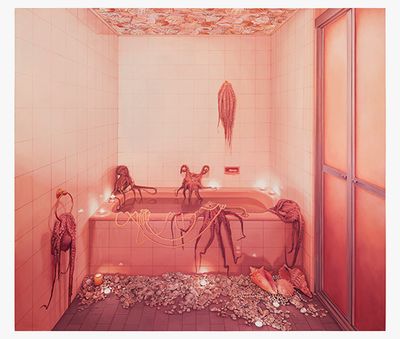
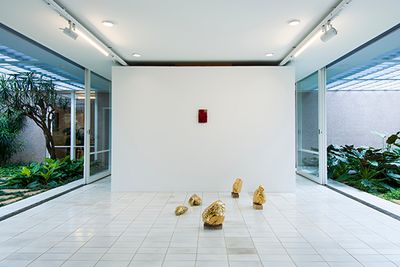
![Michelangelo Pistoletto, Senza Titolo 92 [Untitled 92] (1976–2013). Mixed media. Presented by Galleria Continua at SP-Arte 2017, São Paulo (6–9 April 2017).](https://files.ocula.com/anzax/Content/Reports%2FSP%20Arte%2FSPArte17ContinuaTiagoLima0541_400_0.jpg)
